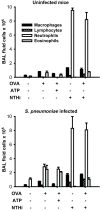Allergic lung inflammation alters neither susceptibility to Streptococcus pneumoniae infection nor inducibility of innate resistance in mice
- PMID: 19635139
- PMCID: PMC2724420
- DOI: 10.1186/1465-9921-10-70
Allergic lung inflammation alters neither susceptibility to Streptococcus pneumoniae infection nor inducibility of innate resistance in mice
Abstract
Background: Protective host responses to respiratory pathogens are typically characterized by inflammation. However, lung inflammation is not always protective and it may even become deleterious to the host. We have recently reported substantial protection against Streptococcus pneumoniae (pneumococcal) pneumonia by induction of a robust inflammatory innate immune response to an inhaled bacterial lysate. Conversely, the allergic inflammation associated with asthma has been proposed to promote susceptibility to pneumococcal disease. This study sought to determine whether preexisting allergic lung inflammation influences the progression of pneumococcal pneumonia or reduces the inducibilty of protective innate immunity against bacteria.
Methods: To compare the effect of different inflammatory and secretory stimuli on defense against pneumonia, intraperitoneally ovalbumin-sensitized mice were challenged with inhaled pneumococci following exposure to various inhaled combinations of ovalbumin, ATP, and/or a bacterial lysate. Thus, allergic inflammation, mucin degranulation and/or stimulated innate resistance were induced prior to the infectious challenge. Pathogen killing was evaluated by assessing bacterial CFUs of lung homogenates immediately after infection, the inflammatory response to the different conditions was evaluated by measurement of cell counts of bronchoalveolar lavage fluid 18 hours after challenge, and mouse survival was assessed after seven days.
Results: We found no differences in survival of mice with and without allergic inflammation, nor did the induction of mucin degranulation alter survival. As we have found previously, mice treated with the bacterial lysate demonstrated substantially increased survival at seven days, and this was not altered by the presence of allergic inflammation or mucin degranulation. Allergic inflammation was associated with predominantly eosinophilic infiltration, whereas the lysate-induced response was primarily neutrophilic. The presence of allergic inflammation did not significantly alter the neutrophilic response to the lysate, and did not affect the induced bacterial killing within the lungs.
Conclusion: These results suggest that allergic airway inflammation neither promotes nor inhibits progression of pneumococcal lung infection in mice, nor does it influence the successful induction of stimulated innate resistance to bacteria.
Figures




Similar articles
-
Allergic airway inflammation disrupts interleukin-17 mediated host defense against streptococcus pneumoniae infection.Int Immunopharmacol. 2016 Feb;31:32-8. doi: 10.1016/j.intimp.2015.12.010. Epub 2015 Dec 14. Int Immunopharmacol. 2016. PMID: 26699848
-
Stimulation of lung innate immunity protects against lethal pneumococcal pneumonia in mice.Am J Respir Crit Care Med. 2008 Jun 15;177(12):1322-30. doi: 10.1164/rccm.200607-1038OC. Epub 2008 Apr 3. Am J Respir Crit Care Med. 2008. PMID: 18388354 Free PMC article.
-
Pneumococcal pneumonia suppresses allergy development but preserves respiratory tolerance in mice.Immunol Lett. 2015 Mar;164(1):44-52. doi: 10.1016/j.imlet.2014.12.001. Epub 2015 Jan 6. Immunol Lett. 2015. PMID: 25576460
-
Role of IgE in the development of allergic airway inflammation and airway hyperresponsiveness--a murine model.Allergy. 1999 Apr;54(4):297-305. doi: 10.1034/j.1398-9995.1999.00085.x. Allergy. 1999. PMID: 10371087 Review.
-
Review: Collectins link innate and adaptive immunity in allergic airway disease.Innate Immun. 2010 Jun;16(3):183-90. doi: 10.1177/1753425910368446. Epub 2010 Apr 23. Innate Immun. 2010. PMID: 20418258 Free PMC article. Review.
Cited by
-
IL-33-mediated Eosinophilia Protects against Acute Lung Injury.Am J Respir Cell Mol Biol. 2021 May;64(5):569-578. doi: 10.1165/rcmb.2020-0166OC. Am J Respir Cell Mol Biol. 2021. PMID: 33571420 Free PMC article.
-
Antiinflammatory role of MUC1 mucin during infection with nontypeable Haemophilus influenzae.Am J Respir Cell Mol Biol. 2012 Feb;46(2):149-56. doi: 10.1165/rcmb.2011-0142OC. Am J Respir Cell Mol Biol. 2012. PMID: 22298528 Free PMC article.
-
Allergic Asthma Favors Brucella Growth in the Lungs of Infected Mice.Front Immunol. 2018 Aug 10;9:1856. doi: 10.3389/fimmu.2018.01856. eCollection 2018. Front Immunol. 2018. PMID: 30147700 Free PMC article.
-
Inhaled innate immune ligands to prevent pneumonia.Br J Pharmacol. 2011 May;163(1):195-206. doi: 10.1111/j.1476-5381.2011.01237.x. Br J Pharmacol. 2011. PMID: 21250981 Free PMC article. Review.
-
Synergistic TLR2/6 and TLR9 activation protects mice against lethal influenza pneumonia.PLoS One. 2012;7(1):e30596. doi: 10.1371/journal.pone.0030596. Epub 2012 Jan 27. PLoS One. 2012. PMID: 22299046 Free PMC article.
References
-
- The World Health Report 2004 – Changing History. Geneva: World Health Organization; 2004.
-
- Advisory Committee on Immunization Practices Preventing Pneumococcal Disease Among Infants and Young Children. Morbid Mortal Week Rev. 2000;49(RR-9):1–38. - PubMed
Publication types
MeSH terms
Substances
Grants and funding
LinkOut - more resources
Full Text Sources
Other Literature Sources
Medical
Research Materials

